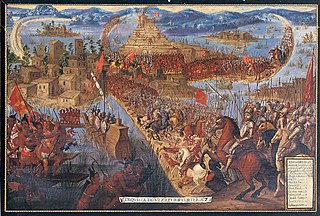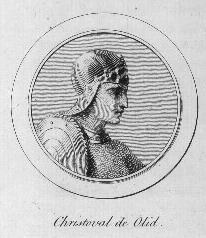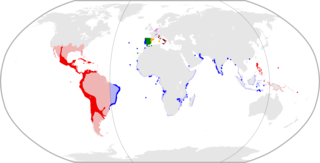The Real Audiencia of Mexico (Spanish : Real Audiencia de México) or high court was the highest tribunal of the Spanish crown in the Kingdom of New Spain (not to be confused with the Viceroyalty of New Spain — named after the kingdom—which had a higher hierarchy and controller). The Audiencia was created by royal decree on December 13, 1527, and was seated in the viceregal capital of Mexico City. The First Audiencia was dissolved by the crown for its bungling and corruption and the crown established the Second Audiencia in 1530. [1] Another Audiencia was created in Guadalajara in western Mexico in 1548.

Spanish or Castilian, is a Western Romance language that originated in the Castile region of Spain and today has hundreds of millions of native speakers in the Americas and Spain. It is a global language and the world's second-most spoken native language, after Mandarin Chinese.

The Crown of Castile was a medieval state in the Iberian Peninsula that formed in 1230 as a result of the third and definitive union of the crowns and, some decades later, the parliaments of the kingdoms of Castile and León upon the accession of the then Castilian king, Ferdinand III, to the vacant Leonese throne. It continued to exist as a separate entity after the personal union in 1469 of the crowns of Castile and Aragon with the marriage of the Catholic Monarchs up to the promulgation of the Nueva Planta decrees by Philip V in 1715.
A namesake is a person named after another, or more broadly, a thing named after a person. According to the Oxford English Dictionary, a namesake is also defined as "a person or thing having the same name as another".
Contents
Assertion of Royal Control After the fall of Tenochtitlan in 1521 conqueror Hernán Cortés exercised power in New Spain as its first European governor and proceeded to allocate rewards to Spaniards who had participated in the victory. [2] He initially established a government in the town of Coyoacán, south of Lake Texcoco, because Tenochtitlan was in ruins after the conquest. From here he governed with the title of Captain General and Justicia Mayor . In his letters to the king, he explained and justified his actions, arguing that it was necessary to grant rewards of encomiendas to conquerors in order to persuade them to remain in the area now under Spanish control rather than see them depart for conquests elsewhere. [3]

Hernán Cortés de Monroy y Pizarro Altamirano, Marquis of the Valley of Oaxaca was a Spanish Conquistador who led an expedition that caused the fall of the Aztec Empire and brought large portions of what is now mainland Mexico under the rule of the King of Castile in the early 16th century. Cortés was part of the generation of Spanish colonizers who began the first phase of the Spanish colonization of the Americas.

Coyoacán is a municipality (alcaldía) of Mexico City and the former village which is now the borough’s “historic center.” The name comes from Nahuatl and most likely means “place of coyotes,” when the Aztecs named a pre-Hispanic village on the southern shore of Lake Texcoco which was dominated by the Tepanec people. Against Aztec domination, these people welcomed Hernán Cortés and the Spanish, who used the area as a headquarters during the Spanish conquest of the Aztec Empire and made it the first capital of New Spain between 1521 and 1523. The village, later municipality, of Coyoacan remained completely independent of Mexico City through the colonial period into the 19th century. In 1857, the area was incorporated into the Federal District when this district was expanded. In 1928, the borough was created when the Federal District was divided into sixteen boroughs. The urban sprawl of Mexico City reached the borough in the mid 20th century, turning farms, former lakes and forests into developed areas, but many of the former villages have kept their original layouts, plazas and narrow streets and have conserved structures built from the 16th to the early 20th centuries. This has made the borough of Coyoacan, especially its historic center, a popular place to visit on weekends.

Lake Texcoco was a natural lake within the "Anahuac" or Valley of Mexico. Lake Texcoco is best known as where the Aztecs built the city of Tenochtitlan, which was located on an island within the lake. After the Spanish conquest of the Aztec Empire, efforts to control flooding by the Spanish led to most of the lake being drained. The entire lake basin is now almost completely occupied by Mexico City, the capital of the present-day nation of Mexico.
The crown sent treasury officials to New Spain, asserting the right of the crown to the revenues from the newly conquered lands. During Cortés's expedition to Honduras (1524–26), treasury officials were left in charge and the political situation descended into chaos. After Cortés's return to Mexico City in 1526, the crown realized that to assert its power over him that a higher level of royal authority was needed and created the Audiencia of Mexico. [4]
The first Audiencia in Mexico was created in 1528 and headed by crown official Nuño Beltrán de Guzmán. Hernán Cortés, who as leader of the Spanish conquest of the Aztec Empire, had accrued considerable wealth and power after the conquest that was not effectively checked by crown treasury officials. By setting up the Audiencia the crown sought to limit Cortés's personal power by creating the high court as an effective instrument of royal power. [5] [6]

The Spanish conquest of the Aztec Empire, or the Spanish–Aztec War (1519–21), was the conquest of the Aztec Empire by the Spanish Empire within the context of the Spanish colonization of the Americas. There are multiple 16th-century narratives of the events by Spanish conquerors, their indigenous allies and the defeated Aztecs. It was not solely a contest between a small contingent of Spaniards defeating the Aztec Empire but rather the creation of a coalition of Spanish invaders with tributaries to the Aztecs, and most especially the Aztecs' indigenous enemies and rivals. They combined forces to defeat the Mexica of Tenochtitlan over a two-year period. For the Spanish, the expedition to Mexico was part of a project of Spanish colonization of the New World after twenty-five years of permanent Spanish settlement and further exploration in the Caribbean.
Guzmán was opposed by the first bishop of Mexico, Juan de Zumárraga, an ally of Cortés [7] Guzmán's tenure as the president of the Audiencia was marked by ruthless attacks on his political rivals, corruption, and extreme violence against Indians. One scholar calls him "a natural gangster." [8] However, structurally the crown had set up a conflictive situation between the conquerors turned encomenderos and the high court determined to assert royal authority. The crown's choice of Nuño de Guzmán as president of the Audiencia was a major blunder. Guzmán largely ignored the crown's instructions and intentions to assert royal authority against the conqueror group and their rewards with Guzmán acting as a rival to accrue power and wealth to himself and his retinue via the power of the Audiencia. [9] The crown rectified its blunder and dissolved the First Audiencia in 1530 and established the Second Audiencia with judges who recognized crown authority; [10] this body functioned until the end of the colonial era.

The Roman Catholic Archdiocese of Mexico is the metropolitan diocese of Mexico City, and responsible for the suffragan Dioceses of Atlacomulco, Cuernavaca, Tenancingo and Toluca. It was elevated on February 12, 1546.

Don Juan de Zumárraga y Arrazola was a Spanish Basque Franciscan prelate and first bishop of Mexico. He wrote Doctrina breve, the first book published in the Western hemisphere, printed in Mexico City in 1539.
In 1532, the Viceroyalty of New Spain was created, although the first Viceroy, Don Antonio de Mendoza, would not arrive in Mexico until 1535. The Viceroy took over the executive functions of government from the Audiencia and served as its president. In the following decade, as more mainland areas were conquered, a second Audiencia was created in Guadalajara, the provincial capital of the Kingdom of New Galicia, in 1548. [11] [12]

Antonio de Mendoza y Pacheco was the first Viceroy of New Spain, serving from November 14, 1535 to November 25, 1550, and the third Viceroy of Peru, from September 23, 1551, until his death on July 21, 1552.
The executive is the organ exercising authority in and holding responsibility for the governance of a state. The executive executes and enforces law.




